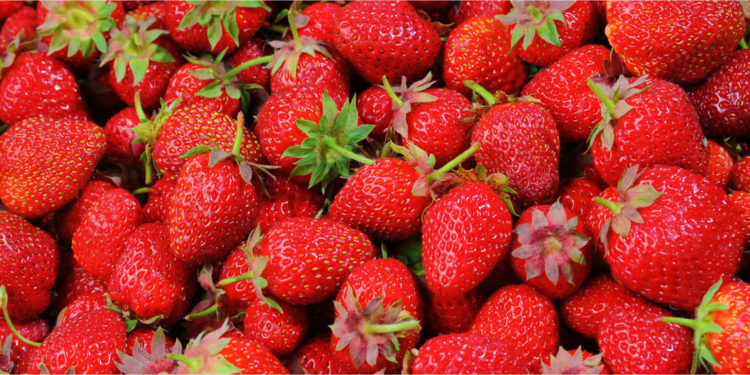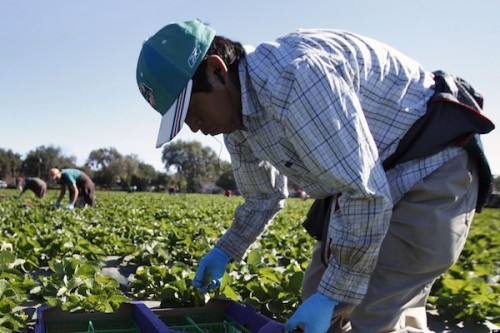
Strawberry Picker Robot Is Coming to Fields
04/24/2015

For years, immigration restrictionists were met with the question, “But who will pick the strawberries?!”
Now the modern answer is here: “Agricultural robots will pick the berries.” The new ag bots can discern ripe strawberries from green and pick them without damage.
Mexicans are so 20th century. Plus they are humans who want water, lunch and rest breaks. Smart machines have no such demands.
The Wall Street Journal report below claims the border is now more secure, causing farm labor shortages, which is crap. The border hasn’t been so wide open in decades — children are breaking in by the thousands. And farmworker visas are available in unlimited numbers.
Anyway, the point about automation is well made.
No wonder Obama is in such a hurry to overwhelm traditional America with freebie-loving Hispanics from the Third World. The universe of plentiful jobs for low-skilled cheap foreign labor is ending.
Robots Step Into New Planting, Harvesting Roles, Wall Street Journal, April 23, 2015Labor shortage spurs farmers to use robots for handling delicate tasks in the fresh-produce industry
OXNARD, Calif. — A 14-arm, automated harvester recently wheeled through rows of strawberry plants here, illustrating an emerging solution to one of the produce industry’s most pressing problems: a shortfall of farmhands.
Harnessing high-powered computing, color sensors and small metal baskets attached to the robotic arms, the machine gently plucked ripe strawberries from below deep-green leaves, while mostly ignoring unripe fruit nearby.
Such tasks have long required the trained discernment and backbreaking effort of tens of thousands of relatively low-paid workers. But technological advances are making it possible for robots to handle the job, just as a shrinking supply of available fruit pickers has made the technology more financially attractive.
“It’s no longer a problem of how much does a strawberry harvester cost,” said Juan Bravo, inventor of Agrobot, the picking machine. “Now it’s about how much does it cost to leave a field unpicked, and that’s a lot more expensive.”
The Agrobot costs about $100,000 and Mr. Bravo has a second, larger prototype in development. Other devices similarly are starting to assume delicate tasks in different parts of the fresh-produce industry, from planting vegetable seedlings to harvesting lettuce to transplanting roses.
Farmers of corn and other commodity crops decades ago replaced most of their workers with giant combines and other machines that can quickly cut and gather grain used for animal feed, food ingredients and ethanol. But growers of produce and plants have largely stuck with human pickers — partly to avoid maladroit machines marring the blemish-free appearance of items that consumers see on store shelves.
An abundant supply of workers, particularly from Mexico, willing to plant, pull weeds and harvest ripe crops for relatively low pay also had suppressed the need for mechanization. But the number of unauthorized immigrants in the U.S. workforce has been declining since its peak in 2007, according to the Pew Research Center, in part because of increased job opportunities in Mexico, as well as tighter U.S. border patrols.
With workers in short supply, “the only way to get more out of the sunshine we have is to elevate the technology,” said Soren Bjorn,Americas unit head for Driscoll Strawberry Associates Inc., the country’s largest berry brand. Driscoll’s largest berry grower, Reiter Affiliated Companies LLC, is partly financing the development of Mr. Bravo’s Agrobot. (Photos: A new way to pick strawberries)
Robots have their own drawbacks. They need maintenance and repair — Agrobot normally has 16 arms, but two were recently on the fritz. Some farmworker advocates worry that increased mechanization could also help eliminate jobs that are still needed. And others fear it will give an additional advantage to large growers that can afford to invest in the latest equipment.
Proponents say increased mechanization of the fresh-produce industry could boost productivity, ultimately helping to tamp down price growth. It also could help farmers in California, who are struggling with a yearslong drought in the country’s largest produce state, get more from their fields, offsetting higher costs.
The labor shortage spurred Tanimura & Antle Fresh Foods Inc., one of the country’s largest vegetable farmers, last year to buy a Spanish startup called Plant Tape, whose system transplants vegetable seedlings from greenhouse to field using strips of biodegradable material fed through a tractor-pulled planting device.
On a recent morning in Salinas, Calif., Tanimura & Antle Chief Executive Rick Antle watched as two workers fed romaine-lettuce seedlings- — encased in the biodegradable strips like a belt of machine-gun bullets — into the device, which precisely cut the seedlings and drove them into the soil. The machine cruised at more than 6 miles an hour — lightning fast for a produce field. In commercial trials, Plant Tape has eliminated at least 10% to 15% of the overall work hours for growing romaine and celery, Mr. Antle said. Plant Tape is now ramping up production so more Tanimura & Antle fields can use it.
Meanwhile, on the same day, the old method was still on display at a Tanimura & Antle celery field down the road. Half of a team of 16 workers slipped celery seedlings into a tractor-pulled machine that plugged them inches apart into rows of soil. The other half, trailing behind, manually smoothed dirt and straightened any misaligned plants. The operation covered about nine-tenths of an acre per hour, which at its fastest was equivalent on average to 0.9 miles an hour.
Tanimura & Antle in recent years has resorted to bringing hundreds of workers in from Mexico on costly, temporary visas for such work. The decades-old system needs to be replaced because “we don’t have the unlimited labor supply we once did,” Mr. Antle said.
Machines are doing more than picking produce. Altman Specialty Plants Inc., one of the country’s largest nurseries, has been using eight, squat robots for the past two years to ferry more than 1.2 million potted roses and other plants to new rows as they grow larger. The $25,000, self-driving machines have occasionally gotten stuck in mud, but they freed eight workers for other jobs and ultimately paid for themselves in 18 months, said Becky Drumright,Altman’s marketing director.
“This is the least desirable job in the entire company,” she said. With machines, “there are no complaints whatsoever. The robots don’t have workers’ compensation, they don’t take breaks.”
Reiter, the Driscoll supplier, is starting to deploy joystick-guided and remote-controlled machines that carry building supplies and boxes of picked produce through berry fields. They free up hundreds of worker hours a year that can be used for other tasks, said Nathan Dorn, the company’s director of farming systems.
Meanwhile, Mr. Bravo is planning a new version of his Agrobot strawberry harvester that will have 60 robotic arms, and require strawberry production on raised, hydroponic beds instead of low, dirt fields. Workers will simply sit atop the machine inspecting and packing berries that pass on a conveyor belt. He plans to begin commercial field trials with his machine this fall.
